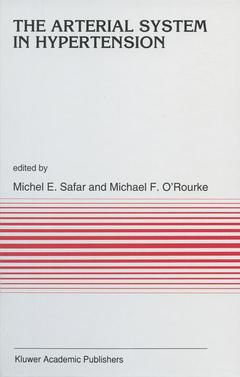The Arterial System in Hypertension, 1993 Developments in Cardiovascular Medicine Series, Vol. 144
Langue : Anglais
Coordonnateurs : Safar Michel Emile, O'Rourke M.F.

MICHEL E. SAFAR and MICHAEL F. O'ROURKE One of the principal problems of hypertension is the precise definition of blood pressure as a cardiovascular risk factor. Clinicians indicate peak systolic pressure and end diastolic pressure in the brachial artery as the principal criteria for blood pressure measurement. Consequently, these values are as indicators for clinical management and therapeutic adjustment. This used methodology, based on indirect blood pressure measurements at the site of the brachial artery relates only to the highest and lowest pressure in that vessel, and does not give any information of the blood pressure curve itself; this carries more information than peak systolic pressure and end diastolic pressure. As a first step in better analysis of the blood pressure curve, research workers in experimental hypertension defined in addition to peak systolic pressure and end diastolic, another blood pressure value, mean arterial pressure, i. e. the average pressure throughout the cardiac cycle, and about which pressure fluctuates. This is the pressure recorded by Hales [1] and by Poiseuille [2] in their pioneering studies. By application of Poiseuille's Law, this definition of mean arterial pressure led to the concept that increased mean arterial pressure (and therefore hypertension) was related, at any given value of cardiac output, to an increase in vascular resistance, i. e. to a reduc tion in the caliber of the small arteries.
Introduction; M.E. Safar, M.F. O'Rourke. 1. Mechanical Stress of the Arterial Wall and Hypertension; S. Laurent. 2. Hypertension and the Conduit and Cushioning Functions of the Arterial Tree; M.F. O'Rourke. 3. Wave Reflections and the Pathophysiology of Hypertension; R.D. Latham, D.M. Slife. 4. Structure of the Arterial System in Hypertension; C.L. Berry, J.A. Sosa-Melgarejo. 5. Cyclic Quasonine Monophosphate, Smooth Muscle Tone and Mechanical Properties of Large Arteries; M.C. Mourlon-Le Grand, B.I. Lévy. 6. Signals Regulating Arterial Contractile Function and Growth in Hypertension: Role of Angiotensin II and Nitric Oxide; J.-B. Michel, J.-F. Arnal. 7. Large Arteries and Epidemiological Aspects of Hypertension; W. McFate Smith. 8. Non-Invasive Study of the Local Mechanical Characteristics in Humans; A.P.G. Hoeks. 9. Geometry and Stiffness of the Arterial Wall in Essential Hypertension; M.E. Safar. 10. Arterial System, Left Ventricular Structure and Function; R. Gourgon, A. Cohen-Solal. 11. Autonomic Nervous System and Large Conduit Arteries: Pathophysiological and Therapeutic Aspects; G.M. London, M.E. Safar. 12. Large Arteries and Sodium in Hypertension: Pathophysiological and Therapeutic Aspects; A. Benetos, M.E. Safar. 13. Large Arteries and Calcium in Hypertension: Pathophysiological and Therapeutic Aspects; G.M. London, B.I. Lévy. 14. Wave Reflections: Clinical and Therapeutic Aspects; G.M. London, T. Yaginuma. Index.
Date de parution : 11-2012
Ouvrage de 240 p.
16x24 cm
Disponible chez l'éditeur (délai d'approvisionnement : 15 jours).
Prix indicatif 52,74 €
Ajouter au panierThème de The Arterial System in Hypertension :
Mots-clés :
Angiotensin II; blood pressure; heart; hypertension; physiology
© 2024 LAVOISIER S.A.S.



